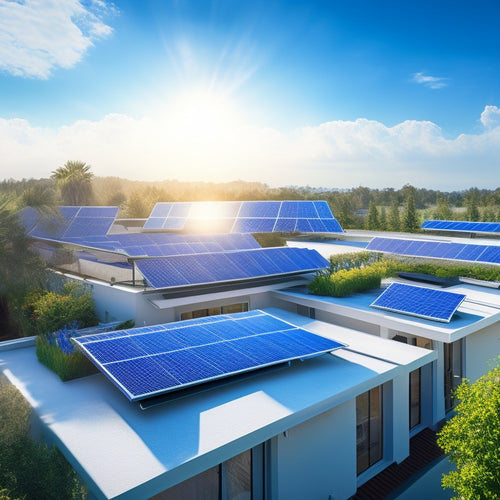
3 Essential Facts About California's Average Solar Installation Costs
Share
As you consider a solar installation in California, it's crucial to know that the average cost ranges from $20,000 to $40,000, with equipment costs making up the largest portion (between $15,000 and $30,000). Labor expenses for installation and maintenance add another $5,000 to $10,000, while permit fees vary regionally, typically falling between $500 and $2,000. Understanding these breakdowns will help you maneuver the intricacies of California's solar market, where local incentives and financing options can greatly influence your upfront costs - and exploring these factors further can help you make the most informed decision for your project.
Key Takeaways
- Average solar installation costs in California range from $15,000 to $30,000, with equipment costs being the largest portion.
- Labor expenses for installation and maintenance typically range from $5,000 to $10,000, depending on the installer's experience and complexity.
- Permit fees vary regionally, generally between $500 and $2,000, contributing to overall installation costs.
- Financing options, such as loans, leases, and power purchase agreements (PPAs), can reduce upfront costs and enhance accessibility.
- System size, installation location, and equipment quality also impact average installation costs in California.
Understanding California's Solar Market
As you maneuver through the Golden State's flourishing renewable energy environment, it's vital to comprehend the forces shaping California's solar market. You'll find that the state's commitment to renewable energy has created a sturdy market for solar installations.
To encourage the adoption of solar energy, California offers various solar incentives, such as the California Solar Initiative (CSI) and the Net Metering program. These incentives help reduce the upfront costs of solar installations, making them more accessible to homeowners and businesses.
When exploring solar installation options, you'll encounter various financing options. You can choose to purchase a solar panel system outright, finance it through a loan, or lease it from a third-party provider. Each option has its pros and cons, so it's important to evaluate your financial situation and energy needs before making a decision.
Understanding the solar market and available financing options will help you steer through the process of going solar in California. By doing so, you'll be well on your way to reducing your reliance on fossil fuels and contributing to a cleaner, more sustainable energy future.
Factors Affecting Installation Costs
You've maneuvered through the California solar market and considered your financing options; now it's time to focus on the factors that affect the cost of your solar installation.
One significant factor is labor expenses, which can vary depending on the installer's experience and the complexity of the installation. The quality of equipment also plays an essential role, as high-efficiency panels and premium inverters come at a higher cost.
The size of your system is another key factor, as larger systems require more materials and labor.
The location of your installation is also important, as installations in urban areas may be more expensive than those in rural areas due to higher labor costs and logistics.
Your financing options can also impact the overall cost, with cash purchases often being more cost-effective than financing through a loan or lease.
Finally, permit fees, which vary by county and municipality, can add to the overall cost.
Understanding these factors will help you make informed decisions when selecting an installer and designing your solar system. By considering these variables, you can find the best balance of cost and quality for your California solar installation.
Breaking Down the Average Cost
The cost of a solar installation in California can be broken down into several key components, including the upfront cost of equipment, labor expenses, and permit fees.
As you consider going solar, it's crucial to understand how these costs contribute to the overall price tag.
When conducting a cost comparison, you'll find that equipment costs account for the largest portion of your total expenditure, typically ranging from $15,000 to $30,000. Labor expenses, including installation and maintenance, typically add another $5,000 to $10,000. Permit fees, which vary by region, can range from $500 to $2,000.
To make solar energy more accessible, financing options are available. You can choose from loans, leases, or power purchase agreements (PPAs), each with its own benefits and drawbacks.
For instance, loans allow you to own the system outright, while leases and PPAs provide lower upfront costs in exchange for ongoing payments. Understanding these components and financing options will help you make an informed decision about your solar installation.
Frequently Asked Questions
Can I Install Solar Panels on a Rented Property?
You can investigate solar lease options for your rented property, but you'll need to negotiate tenant agreements with your landlord, ensuring both parties benefit from the installation and energy savings.
Do Solar Panels Increase My Property's Value?
As you utilize the sun's energy, your property's value shines brighter, too! Installing solar panels increases your property's resale appeal, yielding a coveted asset that attracts eco-conscious buyers, ultimately enhancing your property's worth and sense of community.
Are There Any Financing Options for Solar Installations?
You're exploring financing options for your solar installation, and you've got choices! You can consider solar loans, which offer competitive interest rates, or lease options, where a third-party provider owns the system and you pay for the energy generated.
How Long Does a Typical Solar Installation Take?
You'll steer a typical solar installation's timeline, which spans around 3-6 months, by breaking it down into manageable installation phases, including assessment, permitting, and installation, ensuring a smooth shift to renewable energy.
Can I Install Solar Panels on a Mobile Home?
You can install solar panels on a mobile home, but be prepared for unique mobile home considerations, such as roof load capacity and clearance requirements, that'll impact installation requirements, making it a more complex process than traditional homes.
Conclusion
As you traverse the golden state's solar environment, remember that California's average solar installation costs are like a puzzle - each piece, from market conditions to equipment choices, fits together to reveal the final image. With every thread of information, you're weaving a fabric of understanding, illuminating the path to utilizing the sun's power. Now, you hold the threads of knowledge, ready to stitch together a brighter energy future.
Related Posts
-

Essential Accessories for Heavy Riders of E-Bikes
As a heavy rider of an e-bike, you need specialized gear that caters to your unique needs. Start with safety essentia...
-

What Role Do Unicycles Play in Urban Transport?
As you navigate through congested city streets, unicycles emerge as a viable solution, slashing carbon emissions by u...
-

Best Solar Panel Options for Maximum Energy Savings
You can maximize your energy savings with solar panels that boast efficiency ratings above 20%, paired with extensive...


